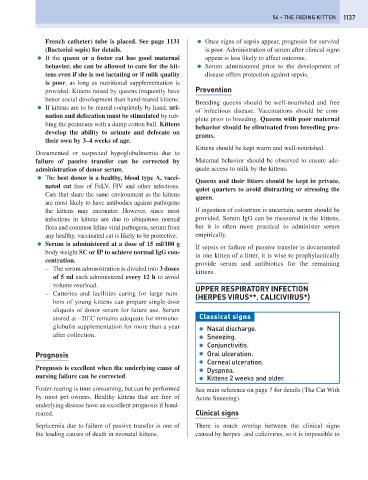Page 1145 - Problem-Based Feline Medicine
P. 1145
54 – THE FADING KITTEN 1137
French catheter) tube is placed. See page 1131 ● Once signs of sepsis appear, prognosis for survival
(Bacterial sepis) for details. is poor. Administration of serum after clinical signs
● If the queen or a foster cat has good maternal appear is less likely to affect outcome.
behavior, she can be allowed to care for the kit- ● Serum administered prior to the development of
tens even if she is not lactating or if milk quality disease offers protection against sepsis.
is poor, as long as nutritional supplementation is
provided. Kittens raised by queens frequently have Prevention
better social development than hand-reared kittens.
Breeding queens should be well-nourished and free
● If kittens are to be reared completely by hand, uri-
of infectious disease. Vaccinations should be com-
nation and defecation must be stimulated by rub-
plete prior to breeding. Queens with poor maternal
bing the perineum with a damp cotton ball. Kittens
behavior should be eliminated from breeding pro-
develop the ability to urinate and defecate on
grams.
their own by 3–4 weeks of age.
Kittens should be kept warm and well-nourished.
Documented or suspected hypoglobulinemia due to
failure of passive transfer can be corrected by Maternal behavior should be observed to ensure ade-
administration of donor serum. quate access to milk by the kittens.
● The best donor is a healthy, blood type A, vacci-
Queens and their litters should be kept in private,
nated cat free of FeLV, FIV and other infections.
quiet quarters to avoid distracting or stressing the
Cats that share the same environment as the kittens
queen.
are most likely to have antibodies against pathogens
the kittens may encounter. However, since most If ingestion of colostrum is uncertain, serum should be
infections in kittens are due to ubiquitous normal provided. Serum IgG can be measured in the kittens,
flora and common feline viral pathogens, serum from but it is often more practical to administer serum
any healthy, vaccinated cat is likely to be protective. empirically.
● Serum is administered at a dose of 15 ml/100 g
If sepsis or failure of passive transfer is documented
body weight SC or IP to achieve normal IgG con-
in one kitten of a litter, it is wise to prophylactically
centration.
provide serum and antibiotics for the remaining
– The serum administration is divided into 3 doses
kittens.
of 5 ml each administered every 12 h to avoid
volume overload.
UPPER RESPIRATORY INFECTION
– Catteries and facilities caring for large num-
(HERPES VIRUS**, CALICIVIRUS*)
bers of young kittens can prepare single-dose
aliquots of donor serum for future use. Serum
stored at –20˚C remains adequate for immuno- Classical signs
globulin supplementation for more than a year ● Nasal discharge.
after collection. ● Sneezing.
● Conjunctivitis.
Prognosis ● Oral ulceration.
● Corneal ulceration.
Prognosis is excellent when the underlying cause of ● Dyspnea.
nursing failure can be corrected. ● Kittens 2 weeks and older.
Foster-rearing is time consuming, but can be performed See main reference on page 7 for details (The Cat With
by most pet owners. Healthy kittens that are free of Acute Sneezing).
underlying disease have an excellent prognosis if hand-
reared. Clinical signs
Septicemia due to failure of passive transfer is one of There is much overlap between the clinical signs
the leading causes of death in neonatal kittens. caused by herpes- and calicivirus, so it is impossible to

